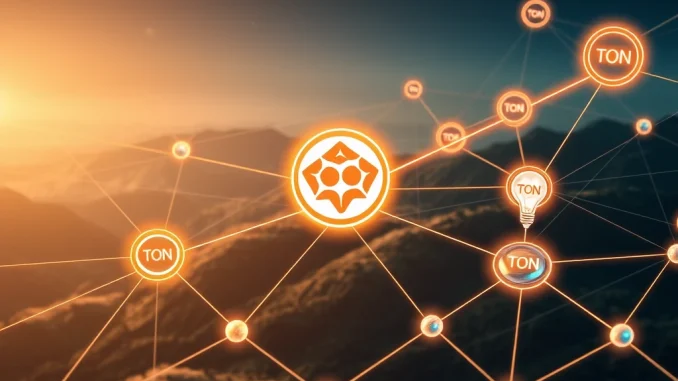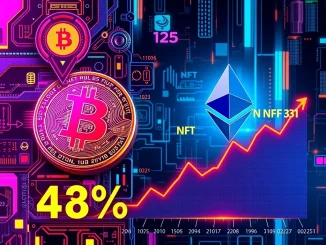
Exciting news for the Tokamak Network community and the broader Ethereum ecosystem! Get ready to dive into the upgraded world of TON Staking because Tokamak Network has just announced the arrival of TON Staking V2! This isn’t just a minor tweak; it’s a significant evolution designed to supercharge their layer-2 solutions and foster a more robust and decentralized ecosystem. If you’re invested in Ethereum layer-2 projects or simply curious about the future of blockchain scaling, this is an update you definitely need to know about.
What is TON Staking V2 and Why Should You Care?
Tokamak Network, a prominent player in the Ethereum layer-2 space, is taking its staking mechanism to the next level with TON Staking V2. But what exactly does this mean, and why is it such a big deal? Let’s break it down.
Essentially, staking in crypto involves locking up your digital assets to support the operations of a blockchain network and, in return, earning rewards. Tokamak Network already had a TON staking mechanism in place (V1), but V2 is a significant upgrade focused on directly incentivizing the unsung heroes of layer-2 networks: the operators, specifically the sequencers.
To understand the V2 upgrade, let’s quickly recap what sequencers do in layer-2 networks:
- Transaction Ordering: Sequencers are responsible for ordering transactions within a layer-2 network before they are submitted to the main Ethereum chain. This ordering is crucial for maintaining the integrity and consistency of the layer-2.
- Block Production (in some cases): Depending on the specific layer-2 architecture, sequencers might also be involved in producing blocks on the layer-2 chain.
- Efficiency Boost: By handling transaction ordering and potentially block production off-chain, sequencers significantly improve the speed and efficiency of transactions compared to processing them directly on Ethereum.
TON Staking V2 is designed to reward these critical sequencers directly. How? Through seigniorage.
Seigniorage: Rewarding Layer-2 Guardians
Seigniorage, in this context, refers to the profit generated from issuing new TON tokens. With TON Staking V2, Tokamak Network will distribute this seigniorage directly to the sequencers operating their layer-2 networks. Think of it as a direct incentive for these operators to maintain and improve the performance of the Tokamak layer-2 ecosystem.
Here’s a simple way to visualize it:
<img src="{{IMAGE_SOURCE_SEIGNIORAGE_FLOW}}" alt="Diagram illustrating seigniorage flow in TON Staking V2, showing TON token issuance and distribution to layer-2 sequencers."]This direct distribution mechanism is a key differentiator of V2 and aims to foster a healthier and more vibrant Tokamak ecosystem.
Boosting Layer-2 Scaling and Ecosystem Growth
Why is incentivizing sequencers so important for Layer-2 scaling? Because robust layer-2 networks are crucial for Ethereum’s scalability and overall adoption. By directly rewarding sequencers, Tokamak Network is strategically addressing several key areas:
- Enhanced Operational Efficiency: Direct incentives encourage operators to invest in better infrastructure and more efficient sequencing processes, leading to faster transaction speeds and lower fees for users on Tokamak-powered layer-2s.
- Attracting Top-Tier Operators: The promise of seigniorage rewards can attract experienced and reputable operators to participate in the Tokamak ecosystem, ensuring high-quality service and network stability.
- Accelerated Ecosystem Development: A well-incentivized and efficient layer-2 infrastructure provides a fertile ground for developers to build and deploy decentralized applications (dApps). This, in turn, fuels the growth of the entire Tokamak Network ecosystem.
In essence, TON Staking V2 acts as a catalyst, accelerating the development and adoption of Tokamak’s layer-2 solutions, ultimately contributing to a more scalable and user-friendly Ethereum.
Advancing Decentralization Through Incentives
Beyond efficiency and growth, TON Staking V2 also plays a crucial role in advancing decentralization within the Tokamak Network. Decentralization is a core tenet of blockchain technology, and it’s essential for security, transparency, and censorship resistance. How does V2 contribute to this?
- Wider Operator Participation: By providing direct financial incentives, TON Staking V2 lowers the barrier to entry for becoming a layer-2 operator. This can lead to a more diverse and geographically distributed set of sequencers, reducing reliance on a small number of centralized entities.
- Reduced Centralization Risks: A more decentralized sequencer set makes the network more resilient to attacks and censorship. It becomes harder for any single entity to control or manipulate the layer-2 network.
- Long-Term Network Health: Incentivizing operators through seigniorage creates a sustainable economic model that supports the long-term health and decentralization of the Tokamak ecosystem. Operators are motivated to act in the best interests of the network as their rewards are directly tied to its success.
By strategically distributing seigniorage, Tokamak Network is not just boosting performance; they are actively fostering a more decentralized and resilient layer-2 infrastructure.
The Impact on Ethereum Layer-2 Landscape
Tokamak Network’s initiative with TON Staking V2 is a significant step forward for the entire Ethereum Layer-2 landscape. It highlights the growing sophistication and innovation within the layer-2 space as projects move beyond basic functionality to focus on robust incentive mechanisms.
Here’s why this is noteworthy for the broader Ethereum ecosystem:
- Setting a New Standard: TON Staking V2 can serve as a model for other layer-2 projects looking to optimize their incentive structures and promote decentralization. It demonstrates the effectiveness of directly rewarding key operational roles like sequencers.
- Fueling Competition and Innovation: As more layer-2 projects adopt innovative incentive mechanisms, it will drive healthy competition and further innovation within the space. This ultimately benefits users with better performance, lower fees, and more decentralized networks.
- Strengthening Ethereum’s Scalability: By making layer-2 solutions more efficient, robust, and decentralized, initiatives like TON Staking V2 directly contribute to Ethereum’s overall scalability and its ability to handle mass adoption.
Tokamak Network is positioning itself at the forefront of this evolution, demonstrating a commitment to building not just scalable but also sustainable and decentralized layer-2 solutions for Ethereum.
Embracing the Future of Crypto Staking and Layer-2s
Crypto staking has become a cornerstone of the blockchain industry, offering users opportunities to earn rewards while contributing to network security and operations. TON Staking V2 exemplifies the evolving nature of staking, showcasing how it can be strategically applied to address specific needs within layer-2 ecosystems.
As the layer-2 space continues to mature, we can expect to see even more innovative staking mechanisms emerge, tailored to the unique requirements of different layer-2 architectures and goals. Tokamak Network’s V2 upgrade is a powerful example of this trend, highlighting the potential of staking to drive growth, efficiency, and decentralization in the ever-expanding world of blockchain technology.
In Conclusion: A Bold Step Towards a Scalable Future
Tokamak Network’s introduction of TON Staking V2 is more than just an upgrade; it’s a strategic move that underscores their commitment to building a thriving and scalable Ethereum ecosystem. By directly incentivizing layer-2 operators through seigniorage distribution, they are not only boosting network performance but also actively fostering decentralization and long-term sustainability.
For anyone invested in the future of Ethereum and layer-2 scaling, TON Staking V2 is a development worth paying close attention to. It represents a significant step forward in the evolution of layer-2 incentive mechanisms and signals a promising direction for the continued growth and adoption of blockchain technology.



